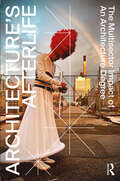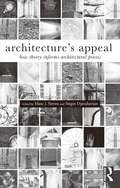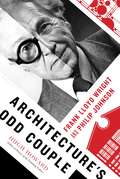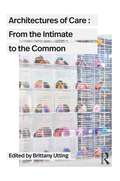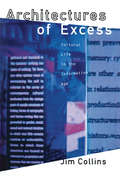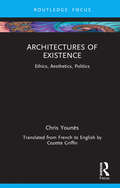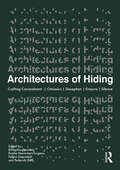- Table View
- List View
Architecture Workbook: Design through Motive
by Sir Peter CookOrganised into 9 parts that highlight a wide range of architectural motives, such as ‘Architecture as Theatre’, ‘Stretching the Vocabulary’ and ‘The City of Large and Small’, the workbook provides inspiring key themes for readers to take their cue from when initiating a design. Motives cover a wide-range of work that epitomise the theme. These include historical and Modernist examples, things observed in the street, work by current innovative architects and from Cook’s own rich archive, weaving together a rich and vibrant visual scrapbook of the everyday and the architectural, and past and present.
Architectures: Modernism and After (New Interventions in Art History)
by Andrew BallantyneArchitectures: Modernism and After surveys the history of the building from the advent of industrialization to the cultural imperatives of the present moment. Brings together international art and architectural historians to consider a range of topics that have influenced the shape, profile, and aesthetics of the built environment. Presents crucial "moments" in the history of the field when the architecture of the past is made to respond to new and changing cultural circumstances. Provides a view of architectural history as a part of a continuing dialogue between aesthetic criteria and social and cultural imperatives. Part of the New Interventions in Art History Series, which is published in conjunction with the Association of Art Historians.
Architecture's Afterlife: The Multisector Impact of an Architecture Degree
by Michela Barosio Dag Boutsen Andrea Čeko Haydée De Loof Johan De Walsche Santiago Gomes Harriet Harriss Roberta Marcaccio Mia Roth-Čerina Carla Sentieri Neal Sashore Federica Vannucchi Hanne Van ReuselAlmost 40% of architecture graduates choose not to practise as architects. Instead, by ‘leaving’ their chosen profession, this surprisingly large but vastly overlooked cohort are making significant contributions to a wide range of other sectors, from politics to videogame design, demonstrating that architectural training can be a pathway to roles, and even leadership opportunities, across a variety of other professions.Architecture’s Afterlife is the first book to examine the sectors into which these graduates migrate, and to identify the transferable skills that are learned, but not always taught, in their degree programmes, and that prove most useful in their new careers.The book – a result of a three-year pan-European study funded by Erasmus+ – provides a roadmap for increasing graduate employment, addressing skills shortages across all sectors and adapting curricula to changing professional landscapes. It is therefore essential reading for all those responsible for curriculum design and delivery in architecture and other disciplines, including deans, professors, postgraduate researchers and policy makers, as well as students and professionals seeking to expand their career prospects.
Architecture's Afterlife: The Multisector Impact of an Architecture Degree
by Michela Barosio Dag Boutsen Andrea Čeko Haydée De Loof Johan De Walsche Santiago Gomes Harriet Harriss Roberta Marcaccio Mia Roth-Čerina Carla Sentieri Neal Sashore Federica Vannucchi Hanne Van ReuselAlmost 40% of architecture graduates choose not to practise as architects. Instead, by ‘leaving’ their chosen profession, this surprisingly large but vastly overlooked cohort are making significant contributions to a wide range of other sectors, from politics to videogame design, demonstrating that architectural training can be a pathway to roles, and even leadership opportunities, across a variety of other professions.Architecture’s Afterlife is the first book to examine the sectors into which these graduates migrate, and to identify the transferable skills that are learned, but not always taught, in their degree programmes, and that prove most useful in their new careers.The book – a result of a three-year pan-European study funded by Erasmus+ – provides a roadmap for increasing graduate employment, addressing skills shortages across all sectors and adapting curricula to changing professional landscapes. It is therefore essential reading for all those responsible for curriculum design and delivery in architecture and other disciplines, including deans, professors, postgraduate researchers and policy makers, as well as students and professionals seeking to expand their career prospects.
Architecture's Appeal: How Theory Informs Architectural Praxis
by Marc J. Neveu Negin DjavaherianThis collection of previously unpublished essays from a diverse range of well-known scholars and architects builds on the architectural tradition of phenomenological hermeneutics as developed by Dalibor Veseley and Joseph Rykwert and carried on by David Leatherbarrow, Peter Carl and Alberto Pérez-Gómez. Taking an interdisciplinary approach and drawing on ideas from beyond the architectural canon, contributors including Kenneth Frampton, David Leatherbarrow, Juhani Pallasmaa, Karsten Harries, Steven Holl, Indra Kagis McEwen, Paul Emmons, and Louise Pelletier offer new insights and perspectives on questions such as the following: Given the recent fascination with all things digital and novel, what is the role of history and theory in contemporary architectural praxis? Is authentic meaning possible in a technological environment that is so global and interconnected? What is the nature and role of the architect in our shared modern world? How can these questions inform a new model of architectural praxis? Architecture's Appeal is a thought-provoking book which will inspire further scholarly inquiry and act as a basis for discussion in the wider field as well as graduate seminars in architectural theory and history.
Architecture's Appeal: How Theory Informs Architectural Praxis
by Marc J. Neveu Negin DjavaherianThis collection of previously unpublished essays from a diverse range of well-known scholars and architects builds on the architectural tradition of phenomenological hermeneutics as developed by Dalibor Veseley and Joseph Rykwert and carried on by David Leatherbarrow, Peter Carl and Alberto Pérez-Gómez. Taking an interdisciplinary approach and drawing on ideas from beyond the architectural canon, contributors including Kenneth Frampton, David Leatherbarrow, Juhani Pallasmaa, Karsten Harries, Steven Holl, Indra Kagis McEwen, Paul Emmons, and Louise Pelletier offer new insights and perspectives on questions such as the following: Given the recent fascination with all things digital and novel, what is the role of history and theory in contemporary architectural praxis? Is authentic meaning possible in a technological environment that is so global and interconnected? What is the nature and role of the architect in our shared modern world? How can these questions inform a new model of architectural praxis? Architecture's Appeal is a thought-provoking book which will inspire further scholarly inquiry and act as a basis for discussion in the wider field as well as graduate seminars in architectural theory and history.
Architecture’s Disability Problem (Routledge Research in Architecture)
by Wanda Katja LiebermannArchitecture’s Disability Problem explores the intersection of architecture and disability in the United States from the perspective of professional practice. This book uncovers why, despite the profound effect of the Americans with Disabilities Act on the architectural profession, there has been so little interest in design for disability in mainstream architecture. To counter this, the book investigates alternative approaches to designing with disability, through three case studies. These showcase both buildings and how design processes driven by disabled people shape design and professional roles.Combining historical research, formal and discourse analysis, and interviews with people who design, construct, use buildings, and advocate for access, the book develops a social understanding of how the buildings work at functional, affective, and symbolic levels. Architecture’s Disability Problem is aimed at three primary readers: practicing architects, architectural scholars, and members of disability scholar-activist communities. Grounded in detailed design studies, the author hopes to unearth the social meaning-making of architecture related to disability. Ultimately, the book makes an argument for a focus on disability in its own right—as well as on the body—in place of the dominance of formal, object-oriented approaches.This book presents and argues for a fundamental shift in the way architectural education, policy, and practice views and engages with disability. It will be key reading for students, researchers, practitioners and policy-makers.
Architecture’s Disability Problem (Routledge Research in Architecture)
by Wanda Katja LiebermannArchitecture’s Disability Problem explores the intersection of architecture and disability in the United States from the perspective of professional practice. This book uncovers why, despite the profound effect of the Americans with Disabilities Act on the architectural profession, there has been so little interest in design for disability in mainstream architecture. To counter this, the book investigates alternative approaches to designing with disability, through three case studies. These showcase both buildings and how design processes driven by disabled people shape design and professional roles.Combining historical research, formal and discourse analysis, and interviews with people who design, construct, use buildings, and advocate for access, the book develops a social understanding of how the buildings work at functional, affective, and symbolic levels. Architecture’s Disability Problem is aimed at three primary readers: practicing architects, architectural scholars, and members of disability scholar-activist communities. Grounded in detailed design studies, the author hopes to unearth the social meaning-making of architecture related to disability. Ultimately, the book makes an argument for a focus on disability in its own right—as well as on the body—in place of the dominance of formal, object-oriented approaches.This book presents and argues for a fundamental shift in the way architectural education, policy, and practice views and engages with disability. It will be key reading for students, researchers, practitioners and policy-makers.
Architecture's Odd Couple: Frank Lloyd Wright and Philip Johnson
by Hugh HowardIn architectural terms, the twentieth century can be largely summed up with two names: Frank Lloyd Wright and Philip Johnson. Wright (1867–1959) began it with his romantic prairie style; Johnson (1906–2005) brought down the curtain with his spare postmodernist experiments. Between them, they built some of the most admired and discussed buildings in American history.Differing radically in their views on architecture, Wright and Johnson shared a restless creativity, enormous charisma, and an outspokenness that made each man irresistible to the media. Often publicly at odds, they were the twentieth century's flint and steel; their repeated encounters consistently set off sparks. Yet as acclaimed historian Hugh Howard shows, their rivalry was also a fruitful artistic conversation, one that yielded new directions for both men. It was not despite but rather because of their contentious--and not always admiring--relationship that they were able so powerfully to influence history.In Architecture's Odd Couple, Howard deftly traces the historical threads connecting the two men and offers readers a distinct perspective on the era they so enlivened with their designs. Featuring many of the structures that defined modern space--from Fallingwater to the Guggenheim, from the Glass House to the Seagram Building--this book presents an arresting portrait of modern architecture's odd couple and how they shaped the American landscape by shaping each other.
Architectures of Care: From the Intimate to the Common
by Brittany UttingDrawing from a diverse range of interdisciplinary voices, this book explores how spaces of care shape our affective, material, and social forms, from the most intimate scale of the body to our planetary commons.Typical definitions of care center around the maintenance of a livable life, encompassing everything from shelter and welfare to health and safety. Architecture plays a fundamental role in these definitions, inscribed in institutional archetypes such as the home, the hospital, the school, and the nursery. However, these spaces often structure modes of care that prescribe gender roles, bodily norms, and labor practices. How can architecture instead engage with an expanded definition of care that questions such roles and norms, producing more hybrid entanglements between our bodies, our collective lives, and our environments? Chapters in this book explore issues ranging from disabled domesticities and nursing, unbuilding whiteness in the built environment, practices and pedagogies of environmental care, and the solidarity networks within ‘The Cloud’. Case studies include Floating University Berlin, commoning initiatives by the Black Panther party, and hospitals for the United Mine Workers of America, among many other sites and scales of care.Exploring architecture through the lenses of gender studies, labor theory, environmental justice, and the medical humanities, this book will engage students and academics from a wide range of disciplines.
Architectures of Care: From the Intimate to the Common
Drawing from a diverse range of interdisciplinary voices, this book explores how spaces of care shape our affective, material, and social forms, from the most intimate scale of the body to our planetary commons.Typical definitions of care center around the maintenance of a livable life, encompassing everything from shelter and welfare to health and safety. Architecture plays a fundamental role in these definitions, inscribed in institutional archetypes such as the home, the hospital, the school, and the nursery. However, these spaces often structure modes of care that prescribe gender roles, bodily norms, and labor practices. How can architecture instead engage with an expanded definition of care that questions such roles and norms, producing more hybrid entanglements between our bodies, our collective lives, and our environments? Chapters in this book explore issues ranging from disabled domesticities and nursing, unbuilding whiteness in the built environment, practices and pedagogies of environmental care, and the solidarity networks within ‘The Cloud’. Case studies include Floating University Berlin, commoning initiatives by the Black Panther party, and hospitals for the United Mine Workers of America, among many other sites and scales of care.Exploring architecture through the lenses of gender studies, labor theory, environmental justice, and the medical humanities, this book will engage students and academics from a wide range of disciplines.
Architectures of Chance (Design Research in Architecture)
by Yeoryia ManolopoulouArchitectural discourse and practice are dominated by a false dichotomy between design and chance, and governed by the belief that the architect’s role is to defend against the indeterminate. In Architectures of Chance Yeoryia Manolopoulou challenges this position, arguing for the need to develop a more creative understanding of chance as aesthetic experience and critical method, and as a design practice in its own right. Examining the role of experimental chance across film, psychoanalysis, philosophy, fine art and performance, this is the first book to comprehensively discuss the idea of chance in architecture and bring a rich array of innovative practices of chance to the attention of architects. Wide-ranging and through a symbiotic interplay of drawing and text, Architectures of Chance makes illuminating reading for those interested in the process and experience of design, and the poetics and ethics of chance and space in the overlapping fields of architecture and the aleatoric arts.
Architectures of Chance (Design Research in Architecture)
by Yeoryia ManolopoulouArchitectural discourse and practice are dominated by a false dichotomy between design and chance, and governed by the belief that the architect’s role is to defend against the indeterminate. In Architectures of Chance Yeoryia Manolopoulou challenges this position, arguing for the need to develop a more creative understanding of chance as aesthetic experience and critical method, and as a design practice in its own right. Examining the role of experimental chance across film, psychoanalysis, philosophy, fine art and performance, this is the first book to comprehensively discuss the idea of chance in architecture and bring a rich array of innovative practices of chance to the attention of architects. Wide-ranging and through a symbiotic interplay of drawing and text, Architectures of Chance makes illuminating reading for those interested in the process and experience of design, and the poetics and ethics of chance and space in the overlapping fields of architecture and the aleatoric arts.
The Architectures of Childhood: Children, Modern Architecture and Reconstruction in Postwar England (Ashgate Studies in Architecture)
by Roy KozlovskyBetween 1935 and 1959, the architecture of childhood was at the centre of architectural discourse in a way that is unique in architectural history. Some of the seminal projects of the period, such as the Secondary Modern School at Hunstanton by Peter and Alison Smithson, Le Corbusier’s Unité d’Habitation at Marseilles, or Aldo van Eyck’s playgrounds and orphanage, were designed for children; At CIAM, architects utilized photographs of children to present their visions for reconstruction. The unprecedented visibility of the child to architectural discourse during the period of reconstruction is the starting point for this interdisciplinary study of modern architecture under welfare state patronage. Focusing mainly on England, this book examines a series of innovative buildings and environments developed for children, such as the adventure playground, the Hertfordshire school, the reformed children hospital, Brutalist housing estates, and New Towns. It studies the methods employed by architects, child experts and policy makers to survey, assess and administer the physiological, emotional and developmental needs of the ’user’, the child. It identifies the new aesthetic and spatial order permeating the environments of childhood, based on endowing children with the agency and autonomy to create a self-regulating social order out of their own free will, while rendering their interiority and sociability observable and governable. By inserting the architectural object within a broader social and political context, The Architectures of Childhood situates post-war architecture within the welfare state’s project of governing the self, which most intensively targeted the citizen in the making, the children. Yet the emphasis on the utilization of architecture as an instrument of power does not reduce it into a mere document of social policy, as the author uncovers the surplus of meaning and richness of experience invested in these environments at the historical mom
The Architectures of Childhood: Children, Modern Architecture and Reconstruction in Postwar England (Ashgate Studies in Architecture)
by Roy KozlovskyBetween 1935 and 1959, the architecture of childhood was at the centre of architectural discourse in a way that is unique in architectural history. Some of the seminal projects of the period, such as the Secondary Modern School at Hunstanton by Peter and Alison Smithson, Le Corbusier’s Unité d’Habitation at Marseilles, or Aldo van Eyck’s playgrounds and orphanage, were designed for children; At CIAM, architects utilized photographs of children to present their visions for reconstruction. The unprecedented visibility of the child to architectural discourse during the period of reconstruction is the starting point for this interdisciplinary study of modern architecture under welfare state patronage. Focusing mainly on England, this book examines a series of innovative buildings and environments developed for children, such as the adventure playground, the Hertfordshire school, the reformed children hospital, Brutalist housing estates, and New Towns. It studies the methods employed by architects, child experts and policy makers to survey, assess and administer the physiological, emotional and developmental needs of the ’user’, the child. It identifies the new aesthetic and spatial order permeating the environments of childhood, based on endowing children with the agency and autonomy to create a self-regulating social order out of their own free will, while rendering their interiority and sociability observable and governable. By inserting the architectural object within a broader social and political context, The Architectures of Childhood situates post-war architecture within the welfare state’s project of governing the self, which most intensively targeted the citizen in the making, the children. Yet the emphasis on the utilization of architecture as an instrument of power does not reduce it into a mere document of social policy, as the author uncovers the surplus of meaning and richness of experience invested in these environments at the historical mom
Architectures of Display: Department Stores and Modern Retail (PDF)
by Anca I. Lasc Patricia Lara-Betancourt Margaret Maile PettyThrough an international range of case studies from the 1870s to the present day, this volume analyses strategies of display in department stores and modern retail spaces. Established scholars and emerging researchers working within a range of disciplinary contexts and historiographical traditions shed light on what constitutes modern retail and the ways in which display, retail and interior designers, architects and artists have built and transformed their practice in response to the commercial context.
Architectures of Display: Department Stores and Modern Retail (Routledge Research in Interior Design)
by Anca I. Lasc Patricia Lara-Betancourt Margaret Maile PettyThrough an international range of case studies from the 1870s to the present, this volume analyzes strategies of display in department stores and modern retail spaces. Established scholars and emerging researchers working within a range of disciplinary contexts and historiographical traditions shed light on what constitutes modern retail and the ways in which interior designers, architects, and artists have built or transformed their practice in response to the commercial context.
Architectures of Display: Department Stores and Modern Retail (Routledge Research in Interior Design)
Through an international range of case studies from the 1870s to the present, this volume analyzes strategies of display in department stores and modern retail spaces. Established scholars and emerging researchers working within a range of disciplinary contexts and historiographical traditions shed light on what constitutes modern retail and the ways in which interior designers, architects, and artists have built or transformed their practice in response to the commercial context.
Architectures of Emergency in Turkey: Heritage, Displacement and Catastrophe (Contemporary Turkey)
by Eray Çayli Pinar Aykac Sevcan ErcanChallenging existing political analyses of the state of emergency in Turkey, this volume argues that such states are not merely predetermined by policy and legislation but are produced, regulated, distributed and contested through the built environment in both embodied and symbolic ways.Contributors use empirical critical-spatial research carried out in Turkey over the past decade, exploring heritage, displacement and catastrophes. Contributing to the broader literature on the related concepts of exception, risk, crisis and uncertainty, the book discusses the ways in which these phenomena shape and are shaped by the built environment, and provides context-specific empirical substance to it by focusing on contemporary Turkey. In so doing, it offers nuanced insight into the debate around emergency as well as into recent urban-architectural affairs in Turkey.
Architectures of Emergency in Turkey: Heritage, Displacement and Catastrophe (Contemporary Turkey)
by Eray Çaylı, Pınar Aykaç, and Sevcan ErcanChallenging existing political analyses of the state of emergency in Turkey, this volume argues that such states are not merely predetermined by policy and legislation but are produced, regulated, distributed and contested through the built environment in both embodied and symbolic ways.Contributors use empirical critical-spatial research carried out in Turkey over the past decade, exploring heritage, displacement and catastrophes. Contributing to the broader literature on the related concepts of exception, risk, crisis and uncertainty, the book discusses the ways in which these phenomena shape and are shaped by the built environment, and provides context-specific empirical substance to it by focusing on contemporary Turkey. In so doing, it offers nuanced insight into the debate around emergency as well as into recent urban-architectural affairs in Turkey.
Architectures of Excess: Cultural Life in the Information Age
by Jim CollinsFirst Published in 1995. Much of recent theory has characterized life in media-sophisticated societies in terms of a semiotic overload which, allegedly, has had only devastating effects on communication and subjectivity. In Architectures of Excess, Jim Collins argues that, while the rate of technological change has indeed accelerated, so has the rate of absorption. The seemingly endless array of information has generated not chaos but different structures and strategies, which harness that excess by turning it into forms of art and entertainment. Digital sampling in rap music and cyber-punk science fiction are well-known examples of techno-pop textuality, but Collins concentrates on other contemporaneous phenomena that are also envisioning new cultural landscapes by accessing that array--hyper-self-reflexivity in mall movies, best sellers, and prime-time television; the deconstructive vs. new-classical debate in architecture; the emergence of the "New Black Aesthetic;" the development of retro-modernism in interior design and the fashion industries. The analyses of these disparate, discontinous attempts to develop a meaningful sense of location, in an historical as well as a spatial sense, address a cluster of interconnected questions: How is the array of information being "domesticated?" How has appropriationism evolved from the Pop-Art of the sixties to the sampling of the nineties? How has the relationship between tradition, innovation, and evaluation been altered? Architectures of Excess investigates how these phenomena reflect change in taste and subjectivity, considering how we must account for both, pedagogically.
Architectures of Excess: Cultural Life in the Information Age
by Jim CollinsFirst Published in 1995. Much of recent theory has characterized life in media-sophisticated societies in terms of a semiotic overload which, allegedly, has had only devastating effects on communication and subjectivity. In Architectures of Excess, Jim Collins argues that, while the rate of technological change has indeed accelerated, so has the rate of absorption. The seemingly endless array of information has generated not chaos but different structures and strategies, which harness that excess by turning it into forms of art and entertainment. Digital sampling in rap music and cyber-punk science fiction are well-known examples of techno-pop textuality, but Collins concentrates on other contemporaneous phenomena that are also envisioning new cultural landscapes by accessing that array--hyper-self-reflexivity in mall movies, best sellers, and prime-time television; the deconstructive vs. new-classical debate in architecture; the emergence of the "New Black Aesthetic;" the development of retro-modernism in interior design and the fashion industries. The analyses of these disparate, discontinous attempts to develop a meaningful sense of location, in an historical as well as a spatial sense, address a cluster of interconnected questions: How is the array of information being "domesticated?" How has appropriationism evolved from the Pop-Art of the sixties to the sampling of the nineties? How has the relationship between tradition, innovation, and evaluation been altered? Architectures of Excess investigates how these phenomena reflect change in taste and subjectivity, considering how we must account for both, pedagogically.
Architectures of Existence: Ethics, Aesthetics, Politics
by Chris YounèsArchitectures of Existence proposes that philosophical thinking (ecosophical thinking) can inform the way we engage with our world and its inhabitants, as architects, designers and planners, but also as individuals, as people, and as a society. In Art et existence, Maldiney states: "For us, to inhabit is to exist". This book aims to unfold, extend, articulate and thicken this postulate by interweaving architecture, city, landscape, literature and philosophy. It takes up the synergistic lines of long-term research carried out from an ecosophical perspective. Such an attitude explores an art of existing in multiplicity, singularity and openness, manifesting the critical dimension through a reinterpretation of the knotting of the trajectories of time, humanity and its becoming. Insisting on what is between things and beings as well as on what is happening, regenerating, recycling, reviving, saving, diversifying, sparing, recreating, meditating: and so caring. These are all eco-rhythms of a different type between human and non-human, to consider ourselves in the world. In an era of uncertainty and climate threats, this book develops the margins of possibility offered by the subject of architecture. This book will be of interest to researchers and students of architecture, urban planning and philosophy.
Architectures of Existence: Ethics, Aesthetics, Politics
by Chris YounèsArchitectures of Existence proposes that philosophical thinking (ecosophical thinking) can inform the way we engage with our world and its inhabitants, as architects, designers and planners, but also as individuals, as people, and as a society. In Art et existence, Maldiney states: "For us, to inhabit is to exist". This book aims to unfold, extend, articulate and thicken this postulate by interweaving architecture, city, landscape, literature and philosophy. It takes up the synergistic lines of long-term research carried out from an ecosophical perspective. Such an attitude explores an art of existing in multiplicity, singularity and openness, manifesting the critical dimension through a reinterpretation of the knotting of the trajectories of time, humanity and its becoming. Insisting on what is between things and beings as well as on what is happening, regenerating, recycling, reviving, saving, diversifying, sparing, recreating, meditating: and so caring. These are all eco-rhythms of a different type between human and non-human, to consider ourselves in the world. In an era of uncertainty and climate threats, this book develops the margins of possibility offered by the subject of architecture. This book will be of interest to researchers and students of architecture, urban planning and philosophy.
Architectures of Hiding: Crafting Concealment | Omission | Deception | Erasure | Silence
by Rana Abughannam Émélie Desrochers-Turgeon Pallavi Swaranjali Federica GoffiArchitecture manifests as a space of concealment and unconcealment, lethe and alêtheia, enclosure and disclosure, where its making and agency are both hidden and revealed. With an urgency to amplify narratives that are overlooked, silenced and unacknowledged in and by architectural spaces, histories and theories, this book contends the need for a critical study of hiding in the context of architectural processes. It urges the understanding of inherent opportunities, power structures and covert strategies, whether socio-cultural, geo-political, environmental or economic, as they are related to their hidescapes – the constructed landscapes of our built environments participating in the architectures of hiding. Looking at and beyond the intentions and agency that architects possess, architectural spaces lend themselves as apparatuses for various forms of hiding and un(hiding). The examples explored in this book and the creative works presented in the interviews enclosed in the interludes of this publication cover a broad range of geographic and cultural contexts, discursively disclosing hidden aspects of architectural meaning. The book investigates the imaginative intrigue of concealing and revealing in design processes, along with moral responsibilities and ethical dilemmas inherent in crafting concealment through the making and reception of architecture.


